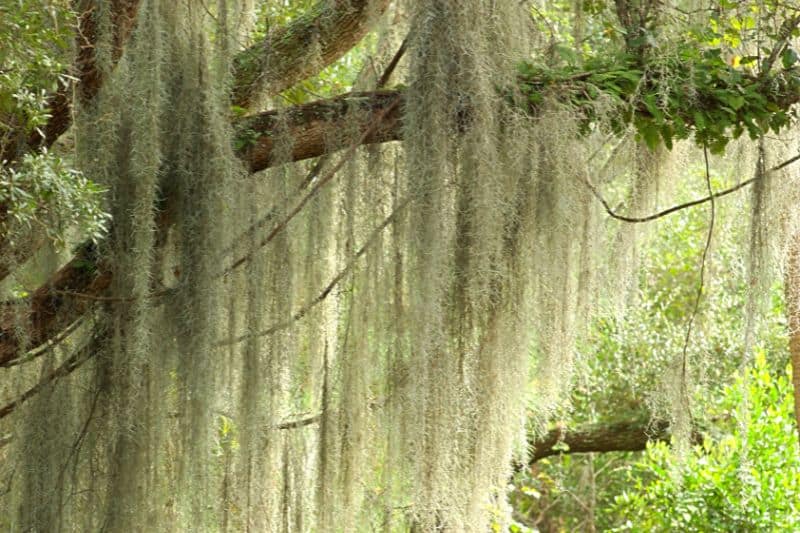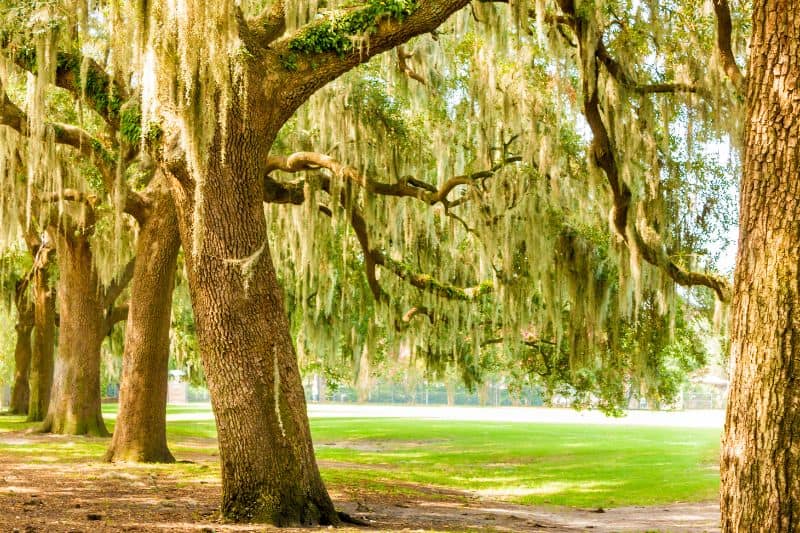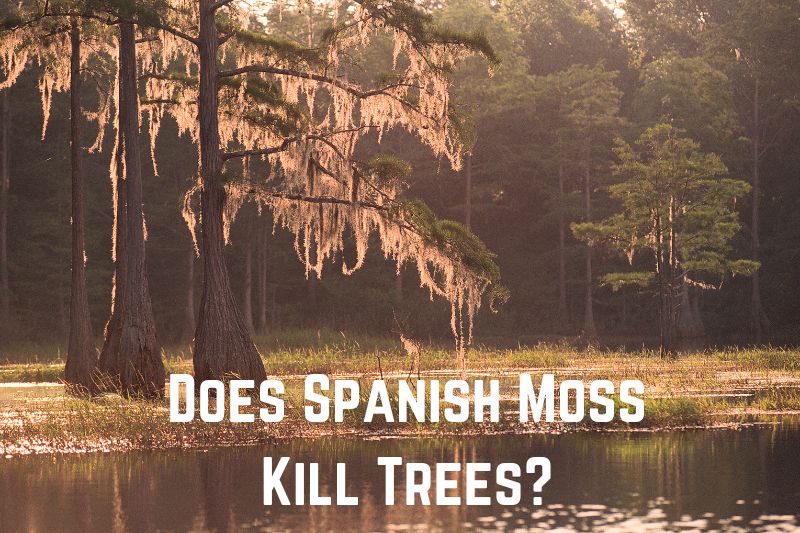Spanish moss, an iconic feature hanging from the branches of trees in the southeastern United States, often sparks curiosity and wonder. You may have found yourself gazing up at these long, grayish-green tendrils draped over tree limbs and wondered if they harm their host.
You’ll be relieved that Spanish moss is not a parasitic plant, meaning it does not harm the trees it calls home by extracting nutrients from them. Rather, Spanish moss is an epiphyte, which attaches itself to the tree for support and accesses nutrients and moisture from the air.
It’s also worth noting that while Spanish moss growth can sometimes be dense, it usually does not have a direct negative impact on the host tree’s health. But coming back to the main question: Does Spanish moss kill trees? Well, it doesn’t!
Read: Will Lime Kill Moss? No! (Answered)
What is Spanish Moss?
The Spanish moss is a type of epiphyte plant; hence, it needs to be supported by another existing plant. It belongs to the kingdom of Plantae and is scientifically called Tillandsia usneoides.
The moss is most commonly used in stuffing nowadays; however, one can also use it to provide insulation in homes and packing materials.
Even though the name is Spanish moss, this plant is neither a fungus nor a moss. Instead, it belongs to the pineapple family from Argentina to coastal Virginia.
Considering the name of this plant, many people would think it comes from Spain, but that is not the case. The name is derived from Native America when the French settlers believed that the plant resembled a Spanish beard and started calling it the Spanish moss.
Apart from the name, the Spanish moss is also known to have many medicinal uses as well. It is used as a dietary supplement and has benefits involving herbal uses for fevers, chills, and wounds.
Will Spanish Moss Kill Trees?
Most people think Spanish moss might kill trees, but they are mistaken. The Spanish moss is not considered a fungus or a parasite and does not harm the tree. The only reason that you may find them on trees is that this plant tends to use those trees to hold themselves upright and help them grow.
Spanish moss grows harmlessly on trees, posing no direct threat to them. As you admire the beautiful drapery of Spanish moss on trees, rest assured that it’s not a parasite. Spanish moss, or Tillandsia usneoides, belongs to the Bromeliad family and is an epiphyte – which means that it gets its water and nutrients from the air and rainfall.
However, in some cases, excessive growth of Spanish moss can become a problem. If the moss gets too dense, it can block sunlight from reaching the tree’s leaves, limiting the tree’s ability to photosynthesize and causing stress. In such cases, monitoring your trees and taking action if the moss becomes too thick is essential.
Removing any excessive Spanish moss growth is a good idea to maintain your trees’ health. You can do this by gently hand-pulling the moss from the branches or using a long-handled rake for hard-to-reach areas. Be cautious not to harm the tree’s bark or branches.
Occasionally, the weight of dense Spanish moss can cause tree limbs to break, especially during heavy rain or strong winds. You can protect your trees from potential damage by ensuring regular monitoring and removal of excessive Spanish moss.
In conclusion, while Spanish moss won’t kill trees directly, it’s essential to keep an eye on its growth and ensure it doesn’t become too dense or heavy for the tree to maintain its health. With proper care and management, you can enjoy the charming sight of Spanish moss without worrying about the well-being of your trees.
Where Does Spanish Moss Originate?
You can find trees covered in Spanish moss in so many different places and trees, but there are some regions where you may find them in a greater quantity. Most Spanish moss is native to the Bermudas, south and west America, and even the Bahamas.
Spanish moss requires a wet and mushy habitat that provides water for the moss. For the Spanish moss to thrive, it must be in a habitat with humidity and rain. These places include swamps, river banks, rainforests, and mangroves. Since they come from a family of pineapples, also called the Ananus comosus, their characteristics mostly match them instead of being the same as other moss in general.
Can Spanish Moss Grow Indoors?
Spanish moss can certainly be grown indoors, provided you create a suitable environment for it. Like any other plant, it requires specific conditions to grow and thrive. Here are some key factors to consider when growing Spanish moss indoors:
First, place your Spanish moss in a location with plenty of indirect sunlight. It is a shade-loving, epiphytic plant, which relies on other plants for support, not nutrients. In its natural habitat, it usually grows on tree branches, where it receives dappled sunlight. Ensure that your room has enough natural light for the moss to photosynthesize properly, but avoid direct sunlight, which can scorch and damage the plant.
Next, consider the temperature and humidity in the space. Spanish moss thrives in humid environments, typically in tropical and subtropical regions. It prefers temperatures in the range of 50-80°F (10-26°C) and humidity levels above 50%.
To maintain a consistent humidity level, you might use a humidifier or mist it regularly with water. Remember that stagnant, moist air can invite diseases and pests, so ensure proper air circulation.
When watering your Spanish moss, remember that it collects water mostly from the air around it. Submerge the moss in water for about 10 minutes once a week, then gently squeeze out any excess water to avoid rotting. Be cautious with tap water, as it may contain minerals that might damage the plant. Using filtered or rainwater can help minimize this risk.
Lastly, consider the support for your Spanish moss. Since it naturally grows on tree branches, recreate that environment by suspending it from a hook or a hanging basket. Ensure it’s not tightly packed or crowded with other plants; it needs adequate airflow to prevent diseases and pests.

How Fast Does Spanish Moss Grow?
Depending on the type of environment in which the Spanish moss is growing, it typically takes around a year to grow 10-20 cm. Since the moss doesn’t require much, it can stay alive and thrive for around two months even if it has gotten no water and isn’t in a humid habitat.
However, if you keep the moss dry for too long or if the environment it’s growing in isn’t sufficient, there is a high chance that your moss might stop growing and die.
Growing Spanish moss may require a lot of patience since its growth is relatively slow. This is because it has no roots or soil that helps it grow. Even if it’s slow, it does grow and tends to start spreading after a significant period.
To avoid that, you can trim the sides of the moss; however, you must make sure not to do it too much or too often since it may result in a messy growth with more sides that start shooting and growing the moss.
If you want your Spanish moss to grow faster than usual, the best trick is to provide it with a lot of moisture. Moisture is the best way to keep Spanish moss from slowing or damaging growth. The Spanish moss grows by itself and has long bloom seasons.
It also thrives when hanging off a tree or, if it’s indoors, on a surface that resembles a tree, like a flat wall or a piece of wood. The best months for the Spanish moss to be able to grow would be the time during spring and fall.
How Does Spanish Moss Grow?
Spanish moss, a common sight hanging from trees in the southeastern United States, might look mysterious, but its growth process is fascinating. If you’ve ever wondered how it manages to thrive without harming the trees it lives on, let’s take a journey through its growth stages.
First of all, you should know that Spanish moss is not a moss or a parasite, but an epiphyte. This means it takes nutrients and water from the air instead of relying on its host tree. It belongs to the bromeliad family, which includes other air plants like Tillandsia.
In some cases, birds may also drop parts of the moss onto another tree, causing it to grow on other trees and living creatures. Typically, moss takes around 6 to 8 weeks to grow, which is relatively rapid.
As an airborne seed, Spanish moss will settle on a tree branch. The tiny seeds have fine, hair-like structures called trichomes that help them anchor to the host tree’s bark. These trichomes are important for the plant’s survival, absorbing water and atmospheric nutrients.
Spanish moss grows through a process called elongation, where the plant extends itself in search of more light. It usually grows downward, creating a signature hanging appearance. While it may look like the Spanish moss is rooted in the tree, it’s just using it for support.
Because Spanish moss has a shallow root system, it’s subject to the whims of wind and rain. As plants grow and break apart, fragments can be carried to new host trees, allowing for the spread of Spanish moss to continue.
Even though Spanish moss is not directly harmful to the trees it inhabits, it can occasionally cause problems. For instance, it can block sunlight if it becomes too dense, reducing the host tree’s ability to photosynthesize. Additionally, the weight of the wet moss can cause stress on branches and lead to breakage.

Does Spanish Moss Have Bugs?
While you may be wondering if Spanish moss kills trees, exploring if it contains any bugs is also essential. In fact, yes, Spanish moss does have bugs living within it. However, before you become concerned, it’s important to understand that these bugs are commonly associated with the plant and do not necessarily harm it or the trees they inhabit.
One bug commonly found in Spanish moss is the chigger, a type of mite that can cause itching and skin irritation for people who come into contact with it. If you’re handling Spanish moss, it’s crucial to wear protective clothing and gloves to avoid any discomfort or potential allergic reactions.
Another insect commonly living within Spanish moss is the green lacewing, which feeds on other smaller insects. Green lacewing is beneficial, as it helps to control the populations of potentially harmful pests.
Occasionally, the Spanish moss can also harbor Southern red mites and mealybugs. While these insects may cause some damage to the moss, they usually don’t pose a threat to the trees themselves.
So, although there are bugs living within Spanish moss, they typically don’t harm the tree where the moss resides. It’s essential to be careful when handling Spanish moss, but there’s no need to be overly concerned about the presence of these insects.
Tree Species Affected by Spanish Moss
Spanish moss is an epiphyte, which means it grows on other plants and trees but doesn’t harm them directly. However, it can sometimes indirectly affect the health of certain tree species. Here are some examples:
Live Oak Trees: Spanish moss thrives on live oak trees due to their dense foliage and horizontal branching pattern. Spanish moss can significantly weigh down the tree’s branches and reduce sunlight exposure, affecting the overall growth of the oak.
Cypress Trees: Similarly, cypress trees are also commonly affected by Spanish moss. While clinging moss to its limbs does not necessarily damage the cypress, it can create issues when the tree is weak or stressed from other factors like drought or disease.
Pecan Trees: Another popular choice for Spanish moss is the pecan tree. Moss growth can inhibit sunlight from reaching the tree’s leaves and as a result, decrease photosynthesis. This can eventually lead to a reduction in fruit production for pecan farmers.
Remember that although Spanish moss is often found on these tree species, it doesn’t always indicate that the tree is in poor health or dying. If you notice Spanish moss on a tree on your property, it’s essential to monitor the tree’s overall health and promptly address any issues that arise to maintain its well-being.
Does Spanish Moss Kill Oak Trees?
In most cases, Spanish moss does not end up doing any harm to the trees. This is because it doesn’t take up any water or nutrients from the trees and only uses it to help them stay steady and to have it grow on the trees. Spanish moss absorbs nutrients from the air around it, keeping the tree healthy and harm-free.
However, oak trees may be a different story because most oak trees tend to have weak branches that are easily breakable. In some instances, the weight of the Spanish moss may end up breaking the branches, which then causes harm to the tree. So unless you don’t prefer how the moss looks on your tree or fear that it might damage it, the best thing to do is remove it.
Frequently Asked Questions
Can Spanish moss smother trees?
Yes, trees can be smothered by Spanish moss, but it is not common. Spanish moss is an epiphyte, which means it takes nutrients and water from the air, and does not harm the host tree directly. However, if the Spanish moss grows excessively on a tree, it can block sunlight from reaching the tree’s leaves, affecting its photosynthesis process.
Why is Spanish moss considered harmful to trees?
Spanish moss can become harmful to trees when it grows in very dense populations, blocking sunlight and affecting the tree’s growth. In addition, it may increase the weight of branches, making them more susceptible to breaking, especially during storms and strong winds. Also, Spanish moss retains moisture, creating a damp environment that may encourage the growth of harmful fungi and bacteria on the bark or leaves of the host tree.
What are the benefits of having Spanish moss on trees?
There are several benefits to having Spanish moss on trees. First, it provides shelter for various small animals and insects, promoting biodiversity in your garden or property. Second, Spanish moss can help to retain moisture in the environment, acting as a natural humidifier in dry conditions. Furthermore, it can also act as air filters, absorbing pollutants like dust and improving air quality. Lastly, Spanish moss is visually appealing and can add character and charm to a landscape.
How does Spanish moss spread from tree to tree?
Spanish moss spreads mainly through wind and bird activity. When birds perch on trees with Spanish moss, the tiny seeds or dislodged fragments can attach to their feathers and are carried to other trees, where they can start to grow. Additionally, wind can carry the lightweight seeds and fragments over short distances, dispersing them in the surrounding area. Spanish moss reproduces both sexually through seed production and asexually as pieces of the moss break off and continue to grow on new hosts.
Conclusion
This blog covers the most frequently asked questions regarding Spanish Moss and its effect on trees. Overall, the Spanish moss has no harmful effects on the tree and only uses the tree as a surface to grow. It is also a plant that you may want as decoration indoors, as long as you take care of it properly and make sure it stays clean and hydrated






